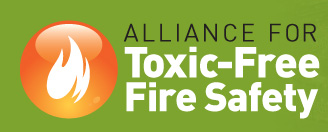  |
|||
November 28, 2012 Cancer-Causing Flame Retardants and Other Toxics Increasingly Found in Couches - New Study Californians Call for Improved Fire Safety Without Chemicals Now (Los Angeles) Physicians, firefighters, consumers, business owners, environmental and public health advocates urge immediate action in response to a new study showing an increase in toxic flame retardants in couches nationwide. Earlier this year, Governor Jerry Brown announced that California’s flammability standard would be updated to promote fire safety and protect the public from toxic chemicals. This study, published in Environmental Science & Technology underscores the immediate need for improved fire safety standards and protection from toxic flame retardant chemicals Sue Chiang, with Center for Environmental Health and a study participant, says, “It is really distressing as a parent of two young children to learn that kids in California have the highest level of flame retardants in their bodies of anywhere in the nation. As a mom, you want to protect your children from harm. I unknowingly brought harm into my home when I purchased a new couch in California laden with flame retardant chemicals. Your home should be a place of comfort, not a place of toxic exposure. California should fast track changing its outdated standards so that families don’t have to be needlessly exposed to these toxic chemicals.” Dr. Arlene Blum, executive director of Green Science Policy Institute, and co-author of the couch study says, “Hard to believe, 35 years after our research contributed to removing chlorinated Tris from children's sleepwear, our current study suggests that more than a third of Americans couches contain the same toxic flame retardant," said Dr. Blum, co-author of the study and executive director of the Green Science Policy Institute. "And sadly enough, many Americans could now have increased cancer risks from the chlorinated Tris in their furniture.” “My couch contains over a pound of the toxic flame retardant chemical, TDCPP, which is known to cause cancer. I am outraged and saddened that there is nothing I can do to protect my family from this toxic exposure until California implements a safer furniture flammability standard. Until then, my family and I, like millions of other people, will continue to be exposed to toxic chemicals from furniture with very limited options for safer alternatives," says Sarah Janssen, MD, PhD, MPH, Senior Scientist Natural Resources Defense Council and Assistant Clinical Professor, UCSF School of Medicine. “As someone who is working to help modernize the California regulation that, de facto, forces toxic flame retardant chemicals into foam for furniture meant for sale in this state, this study became personal when I submitted a foam sample and found out my own couch contains toxic flame retardant chemicals. We know that Governor Brown’s Bureau of Home Furnishings & Thermal Insulation (BHFTI) is working hard on an improved regulation that supports fire safety without the use of toxic flame retardant chemicals. Flame retardant chemical manufacturers are already misrepresenting scientific studies on fire safety and health to keep their toxic products on the market – we support the Governor to keep moving forward with immediate action to protect our health," says Rebecca Sutton,Senior Scientist with Environmental Working Group and study participant. “Communities of color and low-income communities are disproportionately impacted by toxic chemicals from many sources,” says Ana Mascareñas, Policy and Communications Director with Physicians for Social Responsibility - Los Angeles, and coordinator, Californians for Toxic Free Fire Safety. “Many low-income folks hang onto their furniture longer, increasing the chance their furniture contains already banned toxic flame retardant chemicals, and the aging materials continue emitting chemicals in household dust. We’ve tried for several years now to get our state legislature to change or halt this exposure, but the flame retardant chemical industry influence has been too great.” David Levine, CEO of the American Sustainable Business Council (ASBC), states, “It is unfair for businesses that chemicals linked to harmful health impacts are untested and promoted to manufacturers and retailers for use. When there are toxic chemicals in products, consumers demand safer products and with this comes an opportunity for businesses to meet this demand." “Firefighters are at extraordinarily increased risk with flame retardant chemicals in couches,” says Tony Stefani, from the San Francisco Firefighters Cancer Prevention Foundation. “We already suffer from more cancer and unusual cancers than found in the general public. Getting rid of chemicals in couches can help prevent cancer in firefighters and other first responders when couches burn, because they do burn even with the flame retardant chemicals in them. In fact, the chemicals created more soot and smoke, making the fires even more dangerous.” “We can’t shop our way out of this problem - it is almost impossible to buy a ‘safe’ couch.” says Sharyle Patton from Commonweal.
Resources Californians for Toxic Free Fire Safety Action to Urge Governor Brown to Update the Furniture Flammability Standard and Other Actions to Protect the Public from Flame Retardants |
|||




